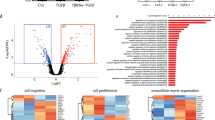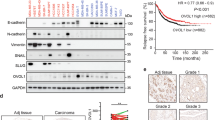Abstract
To better understand the dual, tumour-suppressive and tumour-promoting function of transforming growth factor-β (TGFβ), we analysed mammary epithelial NMuMG cells in response to short and long-term TGFβ exposure. NMuMG cells became proliferation-arrested and apoptotic after exposure to TGFβ for 2–5 days, whereas surviving cells underwent epithelial–mesenchymal transition (EMT). After chronic TGFβ exposure (2–3 weeks), however, NMuMG cells became resistant to proliferation arrest and apoptosis, showing sustained EMT instead (TD cells). EMT was fully reversed by a pharmacologic TGFβ-receptor-I kinase inhibitor or withdrawal of TGFβ for 6–12 days. Interestingly, both cell cycle arresting/proapoptotic (Smads, p38 kinase) and antiapoptotic, proliferation and EMT-promoting signalling pathways (PI3K–PKB/Akt, ERK) were co-suppressed to low, but significant levels. Except for PI3K-Akt, TGFβ-dependent downregulation of these signalling pathways in transdifferentiated (TD) cells was fully reversed upon TGFβ withdrawal, together with partial re-induction of proliferation arrest and apoptosis. Co-injection of non-tumorigenic NMuMG cells with tumour-forming CHO cells oversecreting exogenous TGFβ1 (CHO-TGFβ1) allowed outgrowth of epithelioid cells in CHO-TGFβ1 cell-induced tumours. These epithelial islands enhanced CHO-TGFβ1 tumour cell proliferation, possibly due to chemokines (for example, JE/MCP-1) secreted by NMuMG/TD cells. We conclude that suppression of antiproliferative, proapoptotic TGFβ signalling in TD cells may permit TGFβ-dependent proliferation, survival and EMT-enhancing signalling pathways to act at low levels. Thus, TGFβ may modulate its own signalling to facilitate switching from tumour suppression to tumour progression.
This is a preview of subscription content, access via your institution
Access options
Subscribe to this journal
Receive 50 print issues and online access
$259.00 per year
only $5.18 per issue
Buy this article
- Purchase on Springer Link
- Instant access to full article PDF
Prices may be subject to local taxes which are calculated during checkout









Similar content being viewed by others
References
Balkwill F . (2004). Cancer and the chemokine network. Nat Rev Cancer 4: 540–550.
Dalal BI, Keown PA, Greenberg AH . (1993). Immunocytochemical localization of secreted transforming growth factor-β 1 to the advancing edges of primary tumors and to lymph node metastases of human mammary carcinoma. Am J Pathol 143: 381–389.
Dooley S, Delvoux B, Streckert M, Bonzel L, Stopa M, ten Dijke P et al. (2001). Transforming growth factor β signal transduction in hepatic stellate cells via Smad2/3 phosphorylation, a pathway that is abrogated during in vitro progression to myofibroblasts. TGFβ signal transduction during transdifferentiation of hepatic stellate cells. FEBS Lett 502: 4–10.
Feng X-H, Derynck R . (2005). Specificity and versatility in TGF-β signaling through Smads. Annu Rev Cell Dev Biol 21: 659–693.
Gotzmann J, Huber H, Thallinger C, Wolschek M, Jansen B, Schulte-Hermann R et al. (2002). Hepatocytes convert to a fibroblastoid phenotype through the cooperation of TGF-β1 and Ha-Ras: steps towards invasiveness. J Cell Sci 115: 1189–1202.
Grünert S, Jechlinger M, Beug H . (2003). Diverse cellular and molecular mechanisms contribute to epithelial plasticity and metastasis. Nat Rev Mol Cell Biol 4: 657–665.
Huber MA, Kraut N, Beug H . (2005). Molecular requirements for epithelial–mesenchymal transition during tumor progression. Curr Opin Cell Biol 17: 548–558.
Hui L, Bakiri L, Mairhorfer A, Schweifer N, Haslinger C, Kenner L et al. (2007). p38α suppresses normal and cancer cell proliferation by antagonizing the JNK–c-Jun pathway. Nat Genet 39: 741–749.
Ivanovic V, Melman A, Davis-Joseph B, Valcic M, Geliebter J . (1995). Elevated plasma levels of TGF-β 1 in patients with invasive prostate cancer. Nat Med 1: 282–284.
Janda E, Lehmann K, Killisch I, Jechlinger M, Herzig M, Downward J et al. (2002a). Ras and TGFβ cooperatively regulate epithelial cell plasticity and metastasis: dissection of Ras signaling pathways. J Cell Biol 156: 299–313.
Janda E, Litos G, Grünert S, Downward J, Beug H . (2002b). Oncogenic Ras/Her-2 mediate hyperproliferation of polarized epithelial cells in 3D cultures and rapid tumor growth via the PI3K pathway. Oncogene 21: 5148–5159.
Jechlinger M, Sommer A, Moriggl R, Seither P, Kraut N, Capodiecci P et al. (2006). Autocrine PDGFR signaling promotes mammary cancer metastasis. J Clin Invest 116: 1561–1570.
Kowanetz M, Valcourt U, Bergström R, Heldin C-H, Moustakas A . (2004). Id2 and Id3 define the potency of cell proliferation and differentiation responses to transforming growth factor β and bone morphogenetic protein. Mol Cell Biol 24: 4241–4254.
Levy L, Hill CS . (2006). Alterations in components of the TGF-β superfamily signaling pathways in human cancer. Cytokine Growth Factor Rev 17: 41–58.
Massagué J, Gomis RR . (2006). The logic of TGFβ signaling. FEBS Lett 580: 2811–2820.
Moustakas A, Heldin C-H . (2005). Non-Smad TGF-β signals. J Cell Sci 118: 3573–3584.
Oft M, Peli J, Rudaz C, Schwarz H, Beug H, Reichmann E . (1996). TGF-β1 and Ha-Ras collaborate in modulating the phenotypic plasticity and invasiveness of epithelial tumor cells. Genes Dev 10: 2462–2477.
Pardali K, Moustakas A . (2007). Actions of TGF-β as tumor suppressor and pro-metastatic factor in human cancer. Biochim Biophys Acta 1775: 21–62.
Piek E, Heldin C-H, ten Dijke P . (1999a). Specificity, diversity, and regulation in TGF-β superfamily signaling. FASEB J 13: 2105–2124.
Piek E, Moustakas A, Kurisaki A, Heldin C-H, ten Dijke P . (1999b). TGF-β type I receptor/ALK-5 and Smad proteins mediate epithelial to mesenchymal transdifferentiation in NMuMG breast epithelial cells. J Cell Sci 112 (Part 24): 4557–4568.
Roberts AB, Wakefield LM . (2003). The two faces of transforming growth factor β in carcinogenesis. Proc Natl Acad Sci USA 100: 8621–8623.
Shim KS, Kim KH, Han WS, Park EB . (1999). Elevated serum levels of transforming growth factor-β1 in patients with colorectal carcinoma: its association with tumor progression and its significant decrease after curative surgical resection. Cancer 85: 554–561.
Siegel PM, Massagué J . (2003). Cytostatic and apoptotic actions of TGF-β in homeostasis and cancer. Nat Rev Cancer 3: 807–821.
Sjöblom T, Shimizu A, O'Brien KP, Pietras K, Dal Cin P, Buchdunger E et al. (2001). Growth inhibition of dermatofibrosarcoma protuberans tumors by the platelet-derived growth factor receptor antagonist STI571 through induction of apoptosis. Cancer Res 61: 5778–5783.
Thiery JP, Sleeman JP . (2006). Complex networks orchestrate epithelial–mesenchymal transitions. Nat Rev Mol Cell Biol 7: 131–142.
Waerner T, Alacakaptan M, Tamir I, Oberauer R, Gal A, Brabletz T et al. (2006). Interleukin-like EMT Inducer (ILEI): new cytokine essential for EMT, tumor formation and late events in metastasis in epithelial cells. Cancer Cell 10: 227–239.
Acknowledgements
We thank K Miyazono for the lac-z adenovirus and the CHO-TGFβ1 cell clone, and S Dooley for the CAGA9-luc adenovirus. This work was supported in part by a Human Frontier Science Program grant (AM) and by grants to HB from the Fonds z. Förderung der wiss. Forschung (FWF; SFB F-028), the Forschungsförderungsfonds der gewerbl. Wirtschaft (FFF), and the EU (RTN network EpiPlastCarcinoma; FP6-005428) (AM and HB).
Author information
Authors and Affiliations
Corresponding authors
Additional information
Supplementary Information accompanies the paper on the Oncogene website (http://www.nature.com/onc).
Rights and permissions
About this article
Cite this article
Gal, A., Sjöblom, T., Fedorova, L. et al. Sustained TGFβ exposure suppresses Smad and non-Smad signalling in mammary epithelial cells, leading to EMT and inhibition of growth arrest and apoptosis. Oncogene 27, 1218–1230 (2008). https://doi.org/10.1038/sj.onc.1210741
Received:
Revised:
Accepted:
Published:
Issue Date:
DOI: https://doi.org/10.1038/sj.onc.1210741
Keywords
This article is cited by
-
Role of TGF-β in pancreatic ductal adenocarcinoma progression and PD-L1 expression
Cellular Oncology (2021)
-
Coordination between TGF-β cellular signaling and epigenetic regulation during epithelial to mesenchymal transition
Epigenetics & Chromatin (2019)
-
Contextual determinants of TGFβ action in development, immunity and cancer
Nature Reviews Molecular Cell Biology (2018)
-
Epithelial–mesenchymal transition confers resistance to selective FGFR inhibitors in SNU-16 gastric cancer cells
Gastric Cancer (2016)
-
Epithelial-to-mesenchymal transition is not required for lung metastasis but contributes to chemoresistance
Nature (2015)



